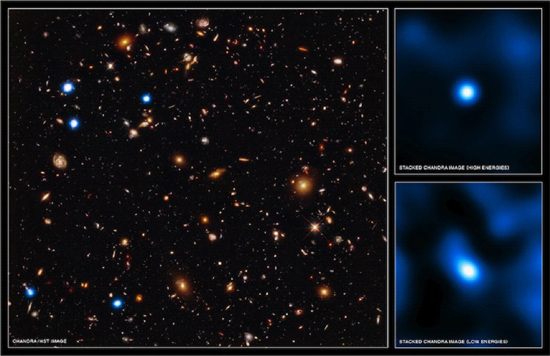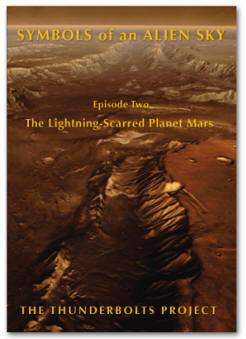|

This composite image from NASA's
Chandra X-ray Observatory and Hubble
Space Telescope (HST combines the
deepest X-ray, optical and infrared
views of the sky. Credit: X-ray:
NASA/CXC U.Hawaii/.Treister et al;
Infrared: NASA/STScI/UC Santa Cruz/G.Illingworth
et al;
Optical: NASA/STScI/S.Beckwith et al
Lines We Neatly Stumble Over
Jun
20, 2011
Enceladus joins other
celestial objects that produce
"magnetic bubbles."
A recent
press release
proclaims that “astronomers have
obtained the first direct evidence
that black holes are common in the
early Universe.” The tortuous path
of prevarication between the
evidence and the hole is direct
evidence of irony.
The evidence provided is a few
blue smudges. To be direct, the
interpretation of these smudges as
black holes in the early universe
must rest on an unquestionable rock
of secure knowledge. Unfortunately,
the easiest way to establish such a
rock is to ignore the questions. The
knowledge so obtained will be secure
as long as skeptical qualms don’t
attenuate the fervency of belief.
Our choicest
plans
have
fallen through,
our airiest castles
tumbled
over,
because of lines
we
neatly drew
and later neatly
stumbled over.
from
Grooks, by Piet
Hein
A skeptical examination reveals
that the conclusion dangles from a
contraption of assumption
cantilevered from prior assumption
and extended precariously over a
bonfire of contradicting evidence.
The “early universe” claim
assumes that redshift is solely a
Doppler effect of receding velocity.
This has been our experience in the
Solar system, so why shouldn’t the
assumption hold true throughout the
universe, despite all the fabulous
and surprising phenomena we’ve
discovered. (In contradiction, much
evidence exists for pairs of objects
with similar high redshifts located
on opposite sides of low-redshift
active galaxies along their spin
axes.)
Extended from this assumption is
the further assumption that the
velocity interpreted from the first
assumption represents a distance.
This is because greater redshift is
associated with smaller and fainter
objects. Assuming that these objects
are all the same size and
luminosity, they must be farther
away to appear smaller and fainter.
In conformity with the “easiest”
way to make a rock of knowledge
secure, as mentioned above, the
possibility that these
smaller and fainter objects are
actually smaller and fainter is
ignored. (In contradiction, direct
evidence—i.e., actual
measurements—shows that the smaller
and fainter members of galaxy
clusters consistently have greater
redshift than the largest and
brightest members.)
If redshift is a measure of
velocity, which is then a measure of
distance, these small faint objects
must actually be huge and
luminous. In fact, they
must be radiating more energy than
the assumed-to-be-securely-known
processes of gravitation and fusion
will allow. The only way to get this
energy density is with a
supernatural concentration of mass.
This is where astronomers retreat
into a
tower of theory sealed
against any contamination by
empirical questions and ignore the
known electromagnetic limits on
compressing matter. They let radius
decrease without limit, divide by
zero, and conclude that density is
infinite: voilà! a black hole, from
which nothing can escape. Having
turned one impossible cartwheel,
they turn another: matter that’s
being pulled into the hole has its
mass (whatever that is) converted
into energy, which does escape—as
the ultraluminous radiation that we
observe. So the black hole that
pulls everything in blows everything
out.
By this time there are so many
adjustable parameters, assumptions,
and imaginary objects that any
amount of energy could be produced.
The black hole is a blank check
written for whatever is needed to
balance theory with observation. To
call this twisted and self-serving
path “direct” is to excuse every
paperhanger who ever bilked his
credulous victims. It’s doubly sad
because these blank-check writers
are
bilking themselves and their
science.
The Electric Universe interprets
the blue smudges as electric
discharges in galaxies whose
distances are indeterminate. Without
measurements of current and voltage,
writing numbers for any of these
quantities would also be writing
blank checks. However, the
electrical processes can be
demonstrated and studied at reduced
scale in a laboratory, and they can
account for the evidence that must
be ignored in the “unquestionable
rock” model. The Electric Universe
is not secure knowledge to be
believed but speculative knowledge
to be experimented with.
Mel Acheson
 New
DVD New
DVD
The Lightning-Scarred
Planet Mars
A video documentary that could
change everything you thought you
knew about ancient times and
symbols. In this second episode of
Symbols of an Alien Sky, David
Talbott takes the viewer on an
odyssey across the surface of Mars.
Exploring feature after feature of
the planet, he finds that only
electric arcs could produce the
observed patterns. The high
resolution images reveal massive
channels and gouges, great mounds,
and crater chains, none finding an
explanation in traditional geology,
but all matching the scars from
electric discharge experiments in
the laboratory. (Approximately 85
minutes)
Video Selections
Order Link
|





 New
DVD
New
DVD

